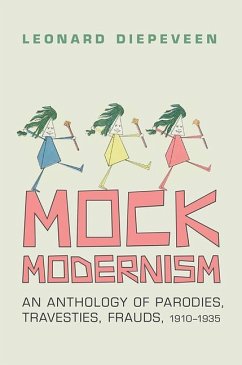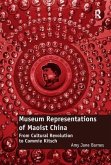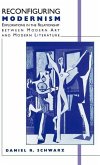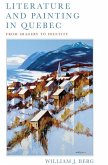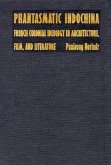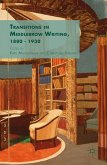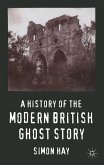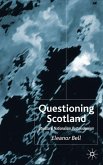- Gebundenes Buch
- Merkliste
- Auf die Merkliste
- Bewerten Bewerten
- Teilen
- Produkt teilen
- Produkterinnerung
- Produkterinnerung
In the earliest decades of the modernist movement many interpretations of it took the form of parodies. Mock Modernism is an anthology of these amusing pieces, the overwhelming majority of which have not been in print since the first decades of the twentieth century.
Andere Kunden interessierten sich auch für
![Museum Representations of Maoist China Museum Representations of Maoist China]() Amy Jane BarnesMuseum Representations of Maoist China204,99 €
Amy Jane BarnesMuseum Representations of Maoist China204,99 €![Reconfiguring Modernism Reconfiguring Modernism]() Daniel R SchwarzReconfiguring Modernism126,99 €
Daniel R SchwarzReconfiguring Modernism126,99 €![Literature and Painting in Quebec Literature and Painting in Quebec]() William J BergLiterature and Painting in Quebec112,99 €
William J BergLiterature and Painting in Quebec112,99 €![Phantasmatic Indochina Phantasmatic Indochina]() Panivong NorindrPhantasmatic Indochina114,99 €
Panivong NorindrPhantasmatic Indochina114,99 €![Transitions in Middlebrow Writing, 1880 - 1930 Transitions in Middlebrow Writing, 1880 - 1930]() Transitions in Middlebrow Writing, 1880 - 193044,99 €
Transitions in Middlebrow Writing, 1880 - 193044,99 €![A History of the Modern British Ghost Story A History of the Modern British Ghost Story]() S. HayA History of the Modern British Ghost Story37,99 €
S. HayA History of the Modern British Ghost Story37,99 €![Questioning Scotland Questioning Scotland]() Eleanor BellQuestioning Scotland63,99 €
Eleanor BellQuestioning Scotland63,99 €-
-
-
In the earliest decades of the modernist movement many interpretations of it took the form of parodies. Mock Modernism is an anthology of these amusing pieces, the overwhelming majority of which have not been in print since the first decades of the twentieth century.
Hinweis: Dieser Artikel kann nur an eine deutsche Lieferadresse ausgeliefert werden.
Hinweis: Dieser Artikel kann nur an eine deutsche Lieferadresse ausgeliefert werden.
Produktdetails
- Produktdetails
- Verlag: University of Toronto Press
- Seitenzahl: 448
- Erscheinungstermin: 6. März 2014
- Englisch
- Abmessung: 229mm x 155mm x 36mm
- Gewicht: 771g
- ISBN-13: 9781442644823
- ISBN-10: 1442644826
- Artikelnr.: 38139229
- Herstellerkennzeichnung
- Libri GmbH
- Europaallee 1
- 36244 Bad Hersfeld
- 06621 890
- Verlag: University of Toronto Press
- Seitenzahl: 448
- Erscheinungstermin: 6. März 2014
- Englisch
- Abmessung: 229mm x 155mm x 36mm
- Gewicht: 771g
- ISBN-13: 9781442644823
- ISBN-10: 1442644826
- Artikelnr.: 38139229
- Herstellerkennzeichnung
- Libri GmbH
- Europaallee 1
- 36244 Bad Hersfeld
- 06621 890
Edited by Leonard Diepeveen
List of Figures
Acknowledgements
Preface
Part I
Literary Targets
I. Poetry
Free verse
1. Squire, John Collings.
* “The Man Who Wrote Free Verse.” The London Mercury June 1924: 127-37.
Rpt. in The Grub Street Nights Entertainments. London: Hodder and
Stoughton 1924 and New York: George H. Doran Company, 1924. 239-64.
* “If a Very New Poet had Written ‘The Lotus-Eaters.’” Tricks of the
Trade. London: Martin Secker, 1917. 65-67.
* “The Poetry of Broken Shackles.” Collected Parodies. London: Hodder &
Stoughton, 1921. 180-81.
2. Randall, Alfred E. “Experiment in Free Rhythm.” The New Age 6.18 (March 3,
1910): 414.
3. Seymour, William Kean. “Thirty-four: A Very New Poet: To Be or Not to Be.”
A Jackdaw in Georgia, a Book of Polite Parodies and Imitations of
Contemporaries and Others. London: J. C. Wilson, 1923. 76-77.
4. Fitzgerald, F. Scott. From This Side of Paradise. New York: Charles
Scribner’s Sons, 1920. 232-34.
5. Taylor, Bert Leston. “The Muse Untrammeled.” A Penny Whistle: Together with
the Babette Ballads. New York: Knopf, 1921. 42-43.
6. Adams, Franklin P. “To a Vers Librist.” Something Else Again. Garden City,
NY: Doubleday, Page & Company, 1920. 43-44.
Prose Poetry
* Squire, John Collings. “The Simple Prose-Poem.” From Collected
Parodies, 185.
* Golden, Sue [pseud] "The Reader Critic. So This is Art!" Little
Review 3.8 (Jan 1917): 27.
* Untermeyer, Louis. “Amy Lowell, Brushing up Her Polyphonic Prose,
Declaims Fortitude.” —-and Other Poets. New York: H. Holt and
Company, 1916. 62-63.
Imagism
* Massingham, Harold. “Recipe for an Imagist Poem.” Form 1.1 (April
1916): 41.
* Upward, Allen. "Correspondence. The Discarded Imagist.” Egoist 2.6
(June 1, 1915): 98.
* Holley, Horace. “Correspondence. Imagists.” The Egoist 1.12 (1914):
236.
* “Imagiste Love Lines.” Columbia Jester. Rpt. in Life January 18 1917:
69.
* Bechhöfer, C.E. “Pastiche.” The New Age 15.20 (1914): 481.
* Aldington, Richard. “Penultimate Poetry.” The Egoist 1.2 (1914): 36.
* Morgan, Emanuel [Witter Bynner]. “Spectrum. ‘Opus 96’.” The Little
Review 4.3 (1917): 25.
* “Pathology des Dommagistes.” The Chapbook. 23 (May 1921): 21-24.
Edgar Lee Masters
* Savage, Henry. From A Long Spoon and the Devil. Being Fish Quaint and
Queer from the Spoon River, the Property of Edgar Lee Masters,
Poached by H. Savage. London: Cecil Palmer, 1922.
* Hoffenstein, Samuel. “Birdie McReynolds.” Year in, You’re Out. New
York: H. Liveright, 1930. 164-65.
* Seymour, William Kean. “A Spoon River Casualty.” In Parrot Pie.
Parodies and Imitations of Contemporaries. London: G. G. Harrap &
Co., 1927. 145.
* Adams, Franklin P. “The Conning Tower.” In Bliss Perry, A Study of
Poetry. Boston: Houghton Mifflin, 1920. 208-09.
The Sitwells
* Knox, Edmund George Valpy. “Spokes: Or an Ode on Ebullitions of
Eccentricity that Ought to have been Overcome in Early Childhood.”
Parodies Regained. London: Methuen & Co., 1921. 31-34.
* Seymour, William Kean. Three Parodies of Edith Sitwell. A Jackdaw in
Georgia, a Book of Polite Parodies and Imitations of Contemporaries
and Others. London: J. C. Wilson, 1923. 1-7.
T. S. Eliot
* Seymour, William Kean. “The Love-Song of J. Ernest Odol.” Parrot Pie.
Parodies and Imitations of Contemporaries. London: G. G. Harrap &
Co., 1927. 43-45.
* Untermeyer, Louis. “Einstein among the Coffee-Cups.” Heavens. New
York: Harcourt, Brace and Company, 1922. 147.
* Scott, F. R. “Sweeney Graduates.” McGilliad 1.2 (Apr. 1930): 9.
* Palmer, Herbert. From Cinder Thursday. London: Ernest Benn, 1931.
11-19.
* Hoffenstein, Samuel. “The Moist Land—A Parody of Eliot’s Poem.” New
York Tribune, Sunday 28 January 1923, sec. VI, p. 24. Rpt. in Samuel
Hoffenstein, Year in, You’re Out. New York: H. Liveright, 1930.
107-117.
* Ward, Christopher. “The Dry Land.” The Triumph of the Nut, and Other
Parodies. New York: Henry Holt and Company, 1923. 170-78.
Ezra Pound
* Untermeyer, Louis. “Ezra Pound.” —-and Other Poets. New York: H. Holt
and Company, 1916. 55-57.
* Bechhöfer, C.E. “More Contemporaries. A Poem of Milton.” The New Age
15.13 (1914): 308.
* Knox, Edmund George Valpy. “The Rovers.” Parodies Regained. London:
Methuen & Co., 1921. 87-91.
* Seymour, William Kean. “Twenty-nine: Mr. Ezra Pound. Boat Race.” A
Jackdaw in Georgia, a Book of Polite Parodies and Imitations of
Contemporaries and Others. London: J. C. Wilson, 1923. 69.
* Taylor, Bert Leston. “A Line-O’-Type Or Two.” Chicago Daily Tribune,
April 18 1913: 8.
* R., W. . "Contemporomania. From 'A Line-O'-Type or Two.'" Chicago
Daily Tribune April 11 1913: 6.
Others
* Ford Madox Ford. “Literary Portraits—XXXIX. Mr W. B. Yeats and his
New Poems.” Outlook, 33 (6 June 1914), 783-84.
* E. E. From “The New England Poets See a Ghost” New Yorker (28 March
1925), 16.
* Crane, Hart. “America’s Plutonic Ecstasies” and “OF AN EVENING
PULLING OFF A LITTLE EXPERIENCE (with the english language)” 1923.
Complete Poems of Hart Crane. Ed. Marc Simon. New York: Liveright,
2000. 157, 179-80.
* Widdemer, Margaret. Selections from A Tree with a Bird in It: A
Symposium of Contemporary American Poets on Being Shown a Pear-Tree
on Which Sat a Grackle. New York: Harcourt, Brace and Company, 1922.
II. Fiction
7. J. G. T. [Thurber, James]. “More Authors Cover the Snyder Trial.” The New
Yorker 7 May 1927: 69.
8. White, E.B. “Is a Train.” The New Yorker 27 October 1934: 26.
9. K. D. “When Helen Furr Got Gay with Harold Moos: A Narrative Written in the
Now Popular Manner of Gertrude Stein.” Vanity Fair October, 1923: 37.
10. Gibbons, Stella. Cold Comfort Farm. London, New York: Longmans, Green and
Co., 1932. 31-34, 38-39, 43-44, 92-93.
11. Parker, Dorothy. “Once More Mother Hubbard—As Told by F. Scott Fitzgerald.”
Life, July 7, 1921.
12. Ward, Christopher.
* “Paradise be Damned!” The Triumph of the Nut, and Other Parodies.
New York: Henry Holt and Company, 1923. 105-118.
* “The Blind Booby.” Twisted Tales. New York: Henry Holt and Company,
1924. 55-64.
* “A Loose Lady.” Twisted Tales. New York: Henry Holt and Company,
1924. 65-74.
13. Knox, Edmund George Valpy. “Mystery” In Apes and Parrots: An Anthology of
Parodies Collected by J.C. Squire. Cambridge: Washburn and Thomas, 1929.
261-66.
14. Rose MacAulay. “Week-end at the Hoppers.” In Parody Party. Ed. Leonard
Russell. London: Hutchinson, 1936. 19-35.
15. Seymour, William Kean. “Peter Gink.” In Parrot Pie. Parodies and Imitations
of Contemporaries. London: G. G. Harrap & Co., 1927. 148-53.
16. Beerbohm, Max. “The Mote in the Middle Distance.” A Christmas Garland.
London: William Heinemann, 1912. 3-10.
17. Squire, J.C. “If Henry James had Written the Church Catechism.” From
Tricks of the Trade. 68-70. Rpt. In Collected Parodies, 91-93.
18. Miles, Susan. “Wednesday or Thursday.” The London Mercury 11:65 (March
1925): 475-78.
Part II
Parodic Modes
I. Verse Commentary
19. Marquis, Don.
* “The Sun Dial: To G. S. And E. P.” New York Evening Sun, October 3
1914.
* “The Sun Dial: The Golden Group.” New York Sun, March 26 1915.
Gertrude Stein and Alice B. Toklas Papers. Yale Collection of
American Literature, Beinecke Rare Book and Manuscript Library, Yale
University.
20. Crane, Carl. “The Reader Writes.” Rpt. in What Cheer: An Anthology of
American and British Humorous and Witty Verse Gathered, Sifted, and Salted,
with an Introduction by David McCord. Ed. David McCord. New York:
Coward-McCann, 1945. 189-90.
21. Adams, Franklin P. “To the Neo-Pseudoists.” By and Large. Garden City, NY:
Doubleday, Page & Company, 1914. 84.
22. Samuel, Horace B. “Futurist Dress.” The New Age 15.7 (1914): 152.
23. Taylor, Bert Leston. “A Line-O’-Type or Two.” Chicago Daily Tribune March
26 1913: 6.
II. Manifestos
24. Knish, Anne, and Emanuel Morgan [Arthur Davison Ficke and Witter Bynner].
* “Preface.” Spectra. A Book of Poetic Experiments. New York: Mitchell
Kennerley, 1916. ix-xii.
* “The Spectric School of Poetry.” The Forum June 1916: 675-77.
25. Meyer, Ernest L. “An Introduction to Ultra-Violet Poetry.” Wisconsin
Literary Magazine (January 1917): 111. Gertrude Stein and Alice B. Toklas
Papers. Yale Collection of American Literature, Beinecke Rare Book and
Manuscript Library, Yale University.
* Cranks, 1921. An Anthology. Compiled by Obert, Sebert, and Ethelberta
Standstill [pseud.]. London: A. H. Stockwell, 1921.
26. Harrison, Harold B. “Pastiche. Initial Manifesto of the ‘Fatuists’ to the
Public.” The New Age 10.22 (1912): 524.
27. Marquis, Don. “Fothergil Finch, The Poet of Revolt.” Hermione and Her
Little Group of Serious Thinkers. New York: D. Appleton and Company, 1916.
24-28.
28. Triboulet, John. “Pastiche. Euphemisme; or, What You Will.” The New Age
16.16 (1915): 434.
III. Modernist Methodologies
29. Squire, John Collings.
* “Short Cuts to Helicon.” Life and Letters. London: Hodder &
Stoughton, 1920. 26-31.
* “Editorial Notes.” The London Mercury August 1928: 337-46.
30. Untermeyer, Louis. “The Manufacture of Verse.” Heavens. New York: Harcourt,
Brace and Company, 1922. 97-105.
* “Modern Masterpieces.” Chicago News, April 11 1923.
31. Sherman, Stuart Pratt. Points of View. New York: Scribner’s, 1924.
32. Eastman, Max. The Literary Mind: Its Place in an Age of Science. New York:
Charles Scribner’s Sons, 1931. 76-78.
33. Lyall, Mary Mills. From The Cubies’ ABC. New York: G.P. Putnam’s Sons,
1913.
34. Harrison, Harold B.
* “Letters to the Editor. Cubism.” The New Age 14.21 (1912): 671
* “Letters to the Editor. Una Picarsita.” The New Age 10.14 (1912):
334.
* “Letters to the Editor. Picasso.” The New Age 10.9 (1911): 212-13.
* “Notes and Comment: Cubist Literature.” [unknown] 1913? Gertrude
Stein and Alice B. Toklas Papers. Yale Collection of American
Literature, Beinecke Rare Book and Manuscript Library, Yale
University.
* Taylor, Bert Leston. “A Line-O’-Type or Two.” Chicago Daily Tribune
March 20, 1913: 6.
35. Bribby. “The Original Cubist.” Chicago Daily Tribune. March 20, 1913, page
1.
36. Taylor, Bert Leston. “A Line-O’-Type or Two.”
* Chicago Daily Tribune March 25, 1913: 8.
* Chicago Daily Tribune April 5, 1913: 8.
37. Street, Julian. From “"Why I Became a Cubist." Everybody's Magazine March
1913: 814-25.
38. Jerdanowitch, Pavel [Paul Jordan Smith]. Disumbrationism. Paul Jordan-Smith
Papers, UCLA Library of Special Collections, Box 42.
39. Exaltation [“Yes, We Have No Bananas”]
40. Aspiration
41. Capitulation
42. Selver, P. “Short Cuts to Literary Success.” The New Age 18.9 (1915):
205-07.
43. A., E. L. “Letters to the Editor. Post-Impressionism.” The New Age 8.7
(1910): 166.
44. Reynolds, Frank. “Post-Impressionist Expressions.” The Illustrated London
News, December 3, 1910: 883.
45. Adams, Franklin P. “The Conning Tower.” Chicago Evening Post April 9. 1913:
8.
46. Marquis, Don. From “Voke Easely and his New Art.” Hermione and Her Little
Group of Serious Thinkers. New York: D. Appleton and Company, 1916. 84-88.
47. Monro, Harold. From Some Contemporary Poets. London: Leonard Parsons, 1920.
9-16.
48. Knox, Edmund George Valpy. “The Trotsky Touch.” A Little Loot. London: G.
Allen & Unwin, 1920. 176-180.
49. Ernest Boyd. From “Aesthete: Model 1924.” The American Mercury, January
1924. 51-56.
IV. Modernist Criticism
50. “Cubist Art Is Explained Clearly by a Post-Impressionist Writer.” Chicago
Inter-Ocean, Mar 21, 1913. 5.
51. Taylor, Bert Leston. “A Line-O’-Type or Two.” Chicago Daily Tribune March
28. 1913: 8.
52. Bechhöfer, C.E.
53. “Pastiche. More Contemporaries.” The New Age 15.4 (1914): 92.
54. Brookfarmer, Charles E. [C. E. Bechhöfer]. “Futile-Ism. Or, All Cackle and
No Osses. (Report of Lectures on “Vital English Art,” by Messrs. Marinetti
and C, R. W. Nevinson, Dore Galleries, Friday Evening, June 12.).” The N
Acknowledgements
Preface
Part I
Literary Targets
I. Poetry
Free verse
1. Squire, John Collings.
* “The Man Who Wrote Free Verse.” The London Mercury June 1924: 127-37.
Rpt. in The Grub Street Nights Entertainments. London: Hodder and
Stoughton 1924 and New York: George H. Doran Company, 1924. 239-64.
* “If a Very New Poet had Written ‘The Lotus-Eaters.’” Tricks of the
Trade. London: Martin Secker, 1917. 65-67.
* “The Poetry of Broken Shackles.” Collected Parodies. London: Hodder &
Stoughton, 1921. 180-81.
2. Randall, Alfred E. “Experiment in Free Rhythm.” The New Age 6.18 (March 3,
1910): 414.
3. Seymour, William Kean. “Thirty-four: A Very New Poet: To Be or Not to Be.”
A Jackdaw in Georgia, a Book of Polite Parodies and Imitations of
Contemporaries and Others. London: J. C. Wilson, 1923. 76-77.
4. Fitzgerald, F. Scott. From This Side of Paradise. New York: Charles
Scribner’s Sons, 1920. 232-34.
5. Taylor, Bert Leston. “The Muse Untrammeled.” A Penny Whistle: Together with
the Babette Ballads. New York: Knopf, 1921. 42-43.
6. Adams, Franklin P. “To a Vers Librist.” Something Else Again. Garden City,
NY: Doubleday, Page & Company, 1920. 43-44.
Prose Poetry
* Squire, John Collings. “The Simple Prose-Poem.” From Collected
Parodies, 185.
* Golden, Sue [pseud] "The Reader Critic. So This is Art!" Little
Review 3.8 (Jan 1917): 27.
* Untermeyer, Louis. “Amy Lowell, Brushing up Her Polyphonic Prose,
Declaims Fortitude.” —-and Other Poets. New York: H. Holt and
Company, 1916. 62-63.
Imagism
* Massingham, Harold. “Recipe for an Imagist Poem.” Form 1.1 (April
1916): 41.
* Upward, Allen. "Correspondence. The Discarded Imagist.” Egoist 2.6
(June 1, 1915): 98.
* Holley, Horace. “Correspondence. Imagists.” The Egoist 1.12 (1914):
236.
* “Imagiste Love Lines.” Columbia Jester. Rpt. in Life January 18 1917:
69.
* Bechhöfer, C.E. “Pastiche.” The New Age 15.20 (1914): 481.
* Aldington, Richard. “Penultimate Poetry.” The Egoist 1.2 (1914): 36.
* Morgan, Emanuel [Witter Bynner]. “Spectrum. ‘Opus 96’.” The Little
Review 4.3 (1917): 25.
* “Pathology des Dommagistes.” The Chapbook. 23 (May 1921): 21-24.
Edgar Lee Masters
* Savage, Henry. From A Long Spoon and the Devil. Being Fish Quaint and
Queer from the Spoon River, the Property of Edgar Lee Masters,
Poached by H. Savage. London: Cecil Palmer, 1922.
* Hoffenstein, Samuel. “Birdie McReynolds.” Year in, You’re Out. New
York: H. Liveright, 1930. 164-65.
* Seymour, William Kean. “A Spoon River Casualty.” In Parrot Pie.
Parodies and Imitations of Contemporaries. London: G. G. Harrap &
Co., 1927. 145.
* Adams, Franklin P. “The Conning Tower.” In Bliss Perry, A Study of
Poetry. Boston: Houghton Mifflin, 1920. 208-09.
The Sitwells
* Knox, Edmund George Valpy. “Spokes: Or an Ode on Ebullitions of
Eccentricity that Ought to have been Overcome in Early Childhood.”
Parodies Regained. London: Methuen & Co., 1921. 31-34.
* Seymour, William Kean. Three Parodies of Edith Sitwell. A Jackdaw in
Georgia, a Book of Polite Parodies and Imitations of Contemporaries
and Others. London: J. C. Wilson, 1923. 1-7.
T. S. Eliot
* Seymour, William Kean. “The Love-Song of J. Ernest Odol.” Parrot Pie.
Parodies and Imitations of Contemporaries. London: G. G. Harrap &
Co., 1927. 43-45.
* Untermeyer, Louis. “Einstein among the Coffee-Cups.” Heavens. New
York: Harcourt, Brace and Company, 1922. 147.
* Scott, F. R. “Sweeney Graduates.” McGilliad 1.2 (Apr. 1930): 9.
* Palmer, Herbert. From Cinder Thursday. London: Ernest Benn, 1931.
11-19.
* Hoffenstein, Samuel. “The Moist Land—A Parody of Eliot’s Poem.” New
York Tribune, Sunday 28 January 1923, sec. VI, p. 24. Rpt. in Samuel
Hoffenstein, Year in, You’re Out. New York: H. Liveright, 1930.
107-117.
* Ward, Christopher. “The Dry Land.” The Triumph of the Nut, and Other
Parodies. New York: Henry Holt and Company, 1923. 170-78.
Ezra Pound
* Untermeyer, Louis. “Ezra Pound.” —-and Other Poets. New York: H. Holt
and Company, 1916. 55-57.
* Bechhöfer, C.E. “More Contemporaries. A Poem of Milton.” The New Age
15.13 (1914): 308.
* Knox, Edmund George Valpy. “The Rovers.” Parodies Regained. London:
Methuen & Co., 1921. 87-91.
* Seymour, William Kean. “Twenty-nine: Mr. Ezra Pound. Boat Race.” A
Jackdaw in Georgia, a Book of Polite Parodies and Imitations of
Contemporaries and Others. London: J. C. Wilson, 1923. 69.
* Taylor, Bert Leston. “A Line-O’-Type Or Two.” Chicago Daily Tribune,
April 18 1913: 8.
* R., W. . "Contemporomania. From 'A Line-O'-Type or Two.'" Chicago
Daily Tribune April 11 1913: 6.
Others
* Ford Madox Ford. “Literary Portraits—XXXIX. Mr W. B. Yeats and his
New Poems.” Outlook, 33 (6 June 1914), 783-84.
* E. E. From “The New England Poets See a Ghost” New Yorker (28 March
1925), 16.
* Crane, Hart. “America’s Plutonic Ecstasies” and “OF AN EVENING
PULLING OFF A LITTLE EXPERIENCE (with the english language)” 1923.
Complete Poems of Hart Crane. Ed. Marc Simon. New York: Liveright,
2000. 157, 179-80.
* Widdemer, Margaret. Selections from A Tree with a Bird in It: A
Symposium of Contemporary American Poets on Being Shown a Pear-Tree
on Which Sat a Grackle. New York: Harcourt, Brace and Company, 1922.
II. Fiction
7. J. G. T. [Thurber, James]. “More Authors Cover the Snyder Trial.” The New
Yorker 7 May 1927: 69.
8. White, E.B. “Is a Train.” The New Yorker 27 October 1934: 26.
9. K. D. “When Helen Furr Got Gay with Harold Moos: A Narrative Written in the
Now Popular Manner of Gertrude Stein.” Vanity Fair October, 1923: 37.
10. Gibbons, Stella. Cold Comfort Farm. London, New York: Longmans, Green and
Co., 1932. 31-34, 38-39, 43-44, 92-93.
11. Parker, Dorothy. “Once More Mother Hubbard—As Told by F. Scott Fitzgerald.”
Life, July 7, 1921.
12. Ward, Christopher.
* “Paradise be Damned!” The Triumph of the Nut, and Other Parodies.
New York: Henry Holt and Company, 1923. 105-118.
* “The Blind Booby.” Twisted Tales. New York: Henry Holt and Company,
1924. 55-64.
* “A Loose Lady.” Twisted Tales. New York: Henry Holt and Company,
1924. 65-74.
13. Knox, Edmund George Valpy. “Mystery” In Apes and Parrots: An Anthology of
Parodies Collected by J.C. Squire. Cambridge: Washburn and Thomas, 1929.
261-66.
14. Rose MacAulay. “Week-end at the Hoppers.” In Parody Party. Ed. Leonard
Russell. London: Hutchinson, 1936. 19-35.
15. Seymour, William Kean. “Peter Gink.” In Parrot Pie. Parodies and Imitations
of Contemporaries. London: G. G. Harrap & Co., 1927. 148-53.
16. Beerbohm, Max. “The Mote in the Middle Distance.” A Christmas Garland.
London: William Heinemann, 1912. 3-10.
17. Squire, J.C. “If Henry James had Written the Church Catechism.” From
Tricks of the Trade. 68-70. Rpt. In Collected Parodies, 91-93.
18. Miles, Susan. “Wednesday or Thursday.” The London Mercury 11:65 (March
1925): 475-78.
Part II
Parodic Modes
I. Verse Commentary
19. Marquis, Don.
* “The Sun Dial: To G. S. And E. P.” New York Evening Sun, October 3
1914.
* “The Sun Dial: The Golden Group.” New York Sun, March 26 1915.
Gertrude Stein and Alice B. Toklas Papers. Yale Collection of
American Literature, Beinecke Rare Book and Manuscript Library, Yale
University.
20. Crane, Carl. “The Reader Writes.” Rpt. in What Cheer: An Anthology of
American and British Humorous and Witty Verse Gathered, Sifted, and Salted,
with an Introduction by David McCord. Ed. David McCord. New York:
Coward-McCann, 1945. 189-90.
21. Adams, Franklin P. “To the Neo-Pseudoists.” By and Large. Garden City, NY:
Doubleday, Page & Company, 1914. 84.
22. Samuel, Horace B. “Futurist Dress.” The New Age 15.7 (1914): 152.
23. Taylor, Bert Leston. “A Line-O’-Type or Two.” Chicago Daily Tribune March
26 1913: 6.
II. Manifestos
24. Knish, Anne, and Emanuel Morgan [Arthur Davison Ficke and Witter Bynner].
* “Preface.” Spectra. A Book of Poetic Experiments. New York: Mitchell
Kennerley, 1916. ix-xii.
* “The Spectric School of Poetry.” The Forum June 1916: 675-77.
25. Meyer, Ernest L. “An Introduction to Ultra-Violet Poetry.” Wisconsin
Literary Magazine (January 1917): 111. Gertrude Stein and Alice B. Toklas
Papers. Yale Collection of American Literature, Beinecke Rare Book and
Manuscript Library, Yale University.
* Cranks, 1921. An Anthology. Compiled by Obert, Sebert, and Ethelberta
Standstill [pseud.]. London: A. H. Stockwell, 1921.
26. Harrison, Harold B. “Pastiche. Initial Manifesto of the ‘Fatuists’ to the
Public.” The New Age 10.22 (1912): 524.
27. Marquis, Don. “Fothergil Finch, The Poet of Revolt.” Hermione and Her
Little Group of Serious Thinkers. New York: D. Appleton and Company, 1916.
24-28.
28. Triboulet, John. “Pastiche. Euphemisme; or, What You Will.” The New Age
16.16 (1915): 434.
III. Modernist Methodologies
29. Squire, John Collings.
* “Short Cuts to Helicon.” Life and Letters. London: Hodder &
Stoughton, 1920. 26-31.
* “Editorial Notes.” The London Mercury August 1928: 337-46.
30. Untermeyer, Louis. “The Manufacture of Verse.” Heavens. New York: Harcourt,
Brace and Company, 1922. 97-105.
* “Modern Masterpieces.” Chicago News, April 11 1923.
31. Sherman, Stuart Pratt. Points of View. New York: Scribner’s, 1924.
32. Eastman, Max. The Literary Mind: Its Place in an Age of Science. New York:
Charles Scribner’s Sons, 1931. 76-78.
33. Lyall, Mary Mills. From The Cubies’ ABC. New York: G.P. Putnam’s Sons,
1913.
34. Harrison, Harold B.
* “Letters to the Editor. Cubism.” The New Age 14.21 (1912): 671
* “Letters to the Editor. Una Picarsita.” The New Age 10.14 (1912):
334.
* “Letters to the Editor. Picasso.” The New Age 10.9 (1911): 212-13.
* “Notes and Comment: Cubist Literature.” [unknown] 1913? Gertrude
Stein and Alice B. Toklas Papers. Yale Collection of American
Literature, Beinecke Rare Book and Manuscript Library, Yale
University.
* Taylor, Bert Leston. “A Line-O’-Type or Two.” Chicago Daily Tribune
March 20, 1913: 6.
35. Bribby. “The Original Cubist.” Chicago Daily Tribune. March 20, 1913, page
1.
36. Taylor, Bert Leston. “A Line-O’-Type or Two.”
* Chicago Daily Tribune March 25, 1913: 8.
* Chicago Daily Tribune April 5, 1913: 8.
37. Street, Julian. From “"Why I Became a Cubist." Everybody's Magazine March
1913: 814-25.
38. Jerdanowitch, Pavel [Paul Jordan Smith]. Disumbrationism. Paul Jordan-Smith
Papers, UCLA Library of Special Collections, Box 42.
39. Exaltation [“Yes, We Have No Bananas”]
40. Aspiration
41. Capitulation
42. Selver, P. “Short Cuts to Literary Success.” The New Age 18.9 (1915):
205-07.
43. A., E. L. “Letters to the Editor. Post-Impressionism.” The New Age 8.7
(1910): 166.
44. Reynolds, Frank. “Post-Impressionist Expressions.” The Illustrated London
News, December 3, 1910: 883.
45. Adams, Franklin P. “The Conning Tower.” Chicago Evening Post April 9. 1913:
8.
46. Marquis, Don. From “Voke Easely and his New Art.” Hermione and Her Little
Group of Serious Thinkers. New York: D. Appleton and Company, 1916. 84-88.
47. Monro, Harold. From Some Contemporary Poets. London: Leonard Parsons, 1920.
9-16.
48. Knox, Edmund George Valpy. “The Trotsky Touch.” A Little Loot. London: G.
Allen & Unwin, 1920. 176-180.
49. Ernest Boyd. From “Aesthete: Model 1924.” The American Mercury, January
1924. 51-56.
IV. Modernist Criticism
50. “Cubist Art Is Explained Clearly by a Post-Impressionist Writer.” Chicago
Inter-Ocean, Mar 21, 1913. 5.
51. Taylor, Bert Leston. “A Line-O’-Type or Two.” Chicago Daily Tribune March
28. 1913: 8.
52. Bechhöfer, C.E.
53. “Pastiche. More Contemporaries.” The New Age 15.4 (1914): 92.
54. Brookfarmer, Charles E. [C. E. Bechhöfer]. “Futile-Ism. Or, All Cackle and
No Osses. (Report of Lectures on “Vital English Art,” by Messrs. Marinetti
and C, R. W. Nevinson, Dore Galleries, Friday Evening, June 12.).” The N
List of Figures
Acknowledgements
Preface
Part I
Literary Targets
I. Poetry
Free verse
1. Squire, John Collings.
* “The Man Who Wrote Free Verse.” The London Mercury June 1924: 127-37.
Rpt. in The Grub Street Nights Entertainments. London: Hodder and
Stoughton 1924 and New York: George H. Doran Company, 1924. 239-64.
* “If a Very New Poet had Written ‘The Lotus-Eaters.’” Tricks of the
Trade. London: Martin Secker, 1917. 65-67.
* “The Poetry of Broken Shackles.” Collected Parodies. London: Hodder &
Stoughton, 1921. 180-81.
2. Randall, Alfred E. “Experiment in Free Rhythm.” The New Age 6.18 (March 3,
1910): 414.
3. Seymour, William Kean. “Thirty-four: A Very New Poet: To Be or Not to Be.”
A Jackdaw in Georgia, a Book of Polite Parodies and Imitations of
Contemporaries and Others. London: J. C. Wilson, 1923. 76-77.
4. Fitzgerald, F. Scott. From This Side of Paradise. New York: Charles
Scribner’s Sons, 1920. 232-34.
5. Taylor, Bert Leston. “The Muse Untrammeled.” A Penny Whistle: Together with
the Babette Ballads. New York: Knopf, 1921. 42-43.
6. Adams, Franklin P. “To a Vers Librist.” Something Else Again. Garden City,
NY: Doubleday, Page & Company, 1920. 43-44.
Prose Poetry
* Squire, John Collings. “The Simple Prose-Poem.” From Collected
Parodies, 185.
* Golden, Sue [pseud] "The Reader Critic. So This is Art!" Little
Review 3.8 (Jan 1917): 27.
* Untermeyer, Louis. “Amy Lowell, Brushing up Her Polyphonic Prose,
Declaims Fortitude.” —-and Other Poets. New York: H. Holt and
Company, 1916. 62-63.
Imagism
* Massingham, Harold. “Recipe for an Imagist Poem.” Form 1.1 (April
1916): 41.
* Upward, Allen. "Correspondence. The Discarded Imagist.” Egoist 2.6
(June 1, 1915): 98.
* Holley, Horace. “Correspondence. Imagists.” The Egoist 1.12 (1914):
236.
* “Imagiste Love Lines.” Columbia Jester. Rpt. in Life January 18 1917:
69.
* Bechhöfer, C.E. “Pastiche.” The New Age 15.20 (1914): 481.
* Aldington, Richard. “Penultimate Poetry.” The Egoist 1.2 (1914): 36.
* Morgan, Emanuel [Witter Bynner]. “Spectrum. ‘Opus 96’.” The Little
Review 4.3 (1917): 25.
* “Pathology des Dommagistes.” The Chapbook. 23 (May 1921): 21-24.
Edgar Lee Masters
* Savage, Henry. From A Long Spoon and the Devil. Being Fish Quaint and
Queer from the Spoon River, the Property of Edgar Lee Masters,
Poached by H. Savage. London: Cecil Palmer, 1922.
* Hoffenstein, Samuel. “Birdie McReynolds.” Year in, You’re Out. New
York: H. Liveright, 1930. 164-65.
* Seymour, William Kean. “A Spoon River Casualty.” In Parrot Pie.
Parodies and Imitations of Contemporaries. London: G. G. Harrap &
Co., 1927. 145.
* Adams, Franklin P. “The Conning Tower.” In Bliss Perry, A Study of
Poetry. Boston: Houghton Mifflin, 1920. 208-09.
The Sitwells
* Knox, Edmund George Valpy. “Spokes: Or an Ode on Ebullitions of
Eccentricity that Ought to have been Overcome in Early Childhood.”
Parodies Regained. London: Methuen & Co., 1921. 31-34.
* Seymour, William Kean. Three Parodies of Edith Sitwell. A Jackdaw in
Georgia, a Book of Polite Parodies and Imitations of Contemporaries
and Others. London: J. C. Wilson, 1923. 1-7.
T. S. Eliot
* Seymour, William Kean. “The Love-Song of J. Ernest Odol.” Parrot Pie.
Parodies and Imitations of Contemporaries. London: G. G. Harrap &
Co., 1927. 43-45.
* Untermeyer, Louis. “Einstein among the Coffee-Cups.” Heavens. New
York: Harcourt, Brace and Company, 1922. 147.
* Scott, F. R. “Sweeney Graduates.” McGilliad 1.2 (Apr. 1930): 9.
* Palmer, Herbert. From Cinder Thursday. London: Ernest Benn, 1931.
11-19.
* Hoffenstein, Samuel. “The Moist Land—A Parody of Eliot’s Poem.” New
York Tribune, Sunday 28 January 1923, sec. VI, p. 24. Rpt. in Samuel
Hoffenstein, Year in, You’re Out. New York: H. Liveright, 1930.
107-117.
* Ward, Christopher. “The Dry Land.” The Triumph of the Nut, and Other
Parodies. New York: Henry Holt and Company, 1923. 170-78.
Ezra Pound
* Untermeyer, Louis. “Ezra Pound.” —-and Other Poets. New York: H. Holt
and Company, 1916. 55-57.
* Bechhöfer, C.E. “More Contemporaries. A Poem of Milton.” The New Age
15.13 (1914): 308.
* Knox, Edmund George Valpy. “The Rovers.” Parodies Regained. London:
Methuen & Co., 1921. 87-91.
* Seymour, William Kean. “Twenty-nine: Mr. Ezra Pound. Boat Race.” A
Jackdaw in Georgia, a Book of Polite Parodies and Imitations of
Contemporaries and Others. London: J. C. Wilson, 1923. 69.
* Taylor, Bert Leston. “A Line-O’-Type Or Two.” Chicago Daily Tribune,
April 18 1913: 8.
* R., W. . "Contemporomania. From 'A Line-O'-Type or Two.'" Chicago
Daily Tribune April 11 1913: 6.
Others
* Ford Madox Ford. “Literary Portraits—XXXIX. Mr W. B. Yeats and his
New Poems.” Outlook, 33 (6 June 1914), 783-84.
* E. E. From “The New England Poets See a Ghost” New Yorker (28 March
1925), 16.
* Crane, Hart. “America’s Plutonic Ecstasies” and “OF AN EVENING
PULLING OFF A LITTLE EXPERIENCE (with the english language)” 1923.
Complete Poems of Hart Crane. Ed. Marc Simon. New York: Liveright,
2000. 157, 179-80.
* Widdemer, Margaret. Selections from A Tree with a Bird in It: A
Symposium of Contemporary American Poets on Being Shown a Pear-Tree
on Which Sat a Grackle. New York: Harcourt, Brace and Company, 1922.
II. Fiction
7. J. G. T. [Thurber, James]. “More Authors Cover the Snyder Trial.” The New
Yorker 7 May 1927: 69.
8. White, E.B. “Is a Train.” The New Yorker 27 October 1934: 26.
9. K. D. “When Helen Furr Got Gay with Harold Moos: A Narrative Written in the
Now Popular Manner of Gertrude Stein.” Vanity Fair October, 1923: 37.
10. Gibbons, Stella. Cold Comfort Farm. London, New York: Longmans, Green and
Co., 1932. 31-34, 38-39, 43-44, 92-93.
11. Parker, Dorothy. “Once More Mother Hubbard—As Told by F. Scott Fitzgerald.”
Life, July 7, 1921.
12. Ward, Christopher.
* “Paradise be Damned!” The Triumph of the Nut, and Other Parodies.
New York: Henry Holt and Company, 1923. 105-118.
* “The Blind Booby.” Twisted Tales. New York: Henry Holt and Company,
1924. 55-64.
* “A Loose Lady.” Twisted Tales. New York: Henry Holt and Company,
1924. 65-74.
13. Knox, Edmund George Valpy. “Mystery” In Apes and Parrots: An Anthology of
Parodies Collected by J.C. Squire. Cambridge: Washburn and Thomas, 1929.
261-66.
14. Rose MacAulay. “Week-end at the Hoppers.” In Parody Party. Ed. Leonard
Russell. London: Hutchinson, 1936. 19-35.
15. Seymour, William Kean. “Peter Gink.” In Parrot Pie. Parodies and Imitations
of Contemporaries. London: G. G. Harrap & Co., 1927. 148-53.
16. Beerbohm, Max. “The Mote in the Middle Distance.” A Christmas Garland.
London: William Heinemann, 1912. 3-10.
17. Squire, J.C. “If Henry James had Written the Church Catechism.” From
Tricks of the Trade. 68-70. Rpt. In Collected Parodies, 91-93.
18. Miles, Susan. “Wednesday or Thursday.” The London Mercury 11:65 (March
1925): 475-78.
Part II
Parodic Modes
I. Verse Commentary
19. Marquis, Don.
* “The Sun Dial: To G. S. And E. P.” New York Evening Sun, October 3
1914.
* “The Sun Dial: The Golden Group.” New York Sun, March 26 1915.
Gertrude Stein and Alice B. Toklas Papers. Yale Collection of
American Literature, Beinecke Rare Book and Manuscript Library, Yale
University.
20. Crane, Carl. “The Reader Writes.” Rpt. in What Cheer: An Anthology of
American and British Humorous and Witty Verse Gathered, Sifted, and Salted,
with an Introduction by David McCord. Ed. David McCord. New York:
Coward-McCann, 1945. 189-90.
21. Adams, Franklin P. “To the Neo-Pseudoists.” By and Large. Garden City, NY:
Doubleday, Page & Company, 1914. 84.
22. Samuel, Horace B. “Futurist Dress.” The New Age 15.7 (1914): 152.
23. Taylor, Bert Leston. “A Line-O’-Type or Two.” Chicago Daily Tribune March
26 1913: 6.
II. Manifestos
24. Knish, Anne, and Emanuel Morgan [Arthur Davison Ficke and Witter Bynner].
* “Preface.” Spectra. A Book of Poetic Experiments. New York: Mitchell
Kennerley, 1916. ix-xii.
* “The Spectric School of Poetry.” The Forum June 1916: 675-77.
25. Meyer, Ernest L. “An Introduction to Ultra-Violet Poetry.” Wisconsin
Literary Magazine (January 1917): 111. Gertrude Stein and Alice B. Toklas
Papers. Yale Collection of American Literature, Beinecke Rare Book and
Manuscript Library, Yale University.
* Cranks, 1921. An Anthology. Compiled by Obert, Sebert, and Ethelberta
Standstill [pseud.]. London: A. H. Stockwell, 1921.
26. Harrison, Harold B. “Pastiche. Initial Manifesto of the ‘Fatuists’ to the
Public.” The New Age 10.22 (1912): 524.
27. Marquis, Don. “Fothergil Finch, The Poet of Revolt.” Hermione and Her
Little Group of Serious Thinkers. New York: D. Appleton and Company, 1916.
24-28.
28. Triboulet, John. “Pastiche. Euphemisme; or, What You Will.” The New Age
16.16 (1915): 434.
III. Modernist Methodologies
29. Squire, John Collings.
* “Short Cuts to Helicon.” Life and Letters. London: Hodder &
Stoughton, 1920. 26-31.
* “Editorial Notes.” The London Mercury August 1928: 337-46.
30. Untermeyer, Louis. “The Manufacture of Verse.” Heavens. New York: Harcourt,
Brace and Company, 1922. 97-105.
* “Modern Masterpieces.” Chicago News, April 11 1923.
31. Sherman, Stuart Pratt. Points of View. New York: Scribner’s, 1924.
32. Eastman, Max. The Literary Mind: Its Place in an Age of Science. New York:
Charles Scribner’s Sons, 1931. 76-78.
33. Lyall, Mary Mills. From The Cubies’ ABC. New York: G.P. Putnam’s Sons,
1913.
34. Harrison, Harold B.
* “Letters to the Editor. Cubism.” The New Age 14.21 (1912): 671
* “Letters to the Editor. Una Picarsita.” The New Age 10.14 (1912):
334.
* “Letters to the Editor. Picasso.” The New Age 10.9 (1911): 212-13.
* “Notes and Comment: Cubist Literature.” [unknown] 1913? Gertrude
Stein and Alice B. Toklas Papers. Yale Collection of American
Literature, Beinecke Rare Book and Manuscript Library, Yale
University.
* Taylor, Bert Leston. “A Line-O’-Type or Two.” Chicago Daily Tribune
March 20, 1913: 6.
35. Bribby. “The Original Cubist.” Chicago Daily Tribune. March 20, 1913, page
1.
36. Taylor, Bert Leston. “A Line-O’-Type or Two.”
* Chicago Daily Tribune March 25, 1913: 8.
* Chicago Daily Tribune April 5, 1913: 8.
37. Street, Julian. From “"Why I Became a Cubist." Everybody's Magazine March
1913: 814-25.
38. Jerdanowitch, Pavel [Paul Jordan Smith]. Disumbrationism. Paul Jordan-Smith
Papers, UCLA Library of Special Collections, Box 42.
39. Exaltation [“Yes, We Have No Bananas”]
40. Aspiration
41. Capitulation
42. Selver, P. “Short Cuts to Literary Success.” The New Age 18.9 (1915):
205-07.
43. A., E. L. “Letters to the Editor. Post-Impressionism.” The New Age 8.7
(1910): 166.
44. Reynolds, Frank. “Post-Impressionist Expressions.” The Illustrated London
News, December 3, 1910: 883.
45. Adams, Franklin P. “The Conning Tower.” Chicago Evening Post April 9. 1913:
8.
46. Marquis, Don. From “Voke Easely and his New Art.” Hermione and Her Little
Group of Serious Thinkers. New York: D. Appleton and Company, 1916. 84-88.
47. Monro, Harold. From Some Contemporary Poets. London: Leonard Parsons, 1920.
9-16.
48. Knox, Edmund George Valpy. “The Trotsky Touch.” A Little Loot. London: G.
Allen & Unwin, 1920. 176-180.
49. Ernest Boyd. From “Aesthete: Model 1924.” The American Mercury, January
1924. 51-56.
IV. Modernist Criticism
50. “Cubist Art Is Explained Clearly by a Post-Impressionist Writer.” Chicago
Inter-Ocean, Mar 21, 1913. 5.
51. Taylor, Bert Leston. “A Line-O’-Type or Two.” Chicago Daily Tribune March
28. 1913: 8.
52. Bechhöfer, C.E.
53. “Pastiche. More Contemporaries.” The New Age 15.4 (1914): 92.
54. Brookfarmer, Charles E. [C. E. Bechhöfer]. “Futile-Ism. Or, All Cackle and
No Osses. (Report of Lectures on “Vital English Art,” by Messrs. Marinetti
and C, R. W. Nevinson, Dore Galleries, Friday Evening, June 12.).” The N
Acknowledgements
Preface
Part I
Literary Targets
I. Poetry
Free verse
1. Squire, John Collings.
* “The Man Who Wrote Free Verse.” The London Mercury June 1924: 127-37.
Rpt. in The Grub Street Nights Entertainments. London: Hodder and
Stoughton 1924 and New York: George H. Doran Company, 1924. 239-64.
* “If a Very New Poet had Written ‘The Lotus-Eaters.’” Tricks of the
Trade. London: Martin Secker, 1917. 65-67.
* “The Poetry of Broken Shackles.” Collected Parodies. London: Hodder &
Stoughton, 1921. 180-81.
2. Randall, Alfred E. “Experiment in Free Rhythm.” The New Age 6.18 (March 3,
1910): 414.
3. Seymour, William Kean. “Thirty-four: A Very New Poet: To Be or Not to Be.”
A Jackdaw in Georgia, a Book of Polite Parodies and Imitations of
Contemporaries and Others. London: J. C. Wilson, 1923. 76-77.
4. Fitzgerald, F. Scott. From This Side of Paradise. New York: Charles
Scribner’s Sons, 1920. 232-34.
5. Taylor, Bert Leston. “The Muse Untrammeled.” A Penny Whistle: Together with
the Babette Ballads. New York: Knopf, 1921. 42-43.
6. Adams, Franklin P. “To a Vers Librist.” Something Else Again. Garden City,
NY: Doubleday, Page & Company, 1920. 43-44.
Prose Poetry
* Squire, John Collings. “The Simple Prose-Poem.” From Collected
Parodies, 185.
* Golden, Sue [pseud] "The Reader Critic. So This is Art!" Little
Review 3.8 (Jan 1917): 27.
* Untermeyer, Louis. “Amy Lowell, Brushing up Her Polyphonic Prose,
Declaims Fortitude.” —-and Other Poets. New York: H. Holt and
Company, 1916. 62-63.
Imagism
* Massingham, Harold. “Recipe for an Imagist Poem.” Form 1.1 (April
1916): 41.
* Upward, Allen. "Correspondence. The Discarded Imagist.” Egoist 2.6
(June 1, 1915): 98.
* Holley, Horace. “Correspondence. Imagists.” The Egoist 1.12 (1914):
236.
* “Imagiste Love Lines.” Columbia Jester. Rpt. in Life January 18 1917:
69.
* Bechhöfer, C.E. “Pastiche.” The New Age 15.20 (1914): 481.
* Aldington, Richard. “Penultimate Poetry.” The Egoist 1.2 (1914): 36.
* Morgan, Emanuel [Witter Bynner]. “Spectrum. ‘Opus 96’.” The Little
Review 4.3 (1917): 25.
* “Pathology des Dommagistes.” The Chapbook. 23 (May 1921): 21-24.
Edgar Lee Masters
* Savage, Henry. From A Long Spoon and the Devil. Being Fish Quaint and
Queer from the Spoon River, the Property of Edgar Lee Masters,
Poached by H. Savage. London: Cecil Palmer, 1922.
* Hoffenstein, Samuel. “Birdie McReynolds.” Year in, You’re Out. New
York: H. Liveright, 1930. 164-65.
* Seymour, William Kean. “A Spoon River Casualty.” In Parrot Pie.
Parodies and Imitations of Contemporaries. London: G. G. Harrap &
Co., 1927. 145.
* Adams, Franklin P. “The Conning Tower.” In Bliss Perry, A Study of
Poetry. Boston: Houghton Mifflin, 1920. 208-09.
The Sitwells
* Knox, Edmund George Valpy. “Spokes: Or an Ode on Ebullitions of
Eccentricity that Ought to have been Overcome in Early Childhood.”
Parodies Regained. London: Methuen & Co., 1921. 31-34.
* Seymour, William Kean. Three Parodies of Edith Sitwell. A Jackdaw in
Georgia, a Book of Polite Parodies and Imitations of Contemporaries
and Others. London: J. C. Wilson, 1923. 1-7.
T. S. Eliot
* Seymour, William Kean. “The Love-Song of J. Ernest Odol.” Parrot Pie.
Parodies and Imitations of Contemporaries. London: G. G. Harrap &
Co., 1927. 43-45.
* Untermeyer, Louis. “Einstein among the Coffee-Cups.” Heavens. New
York: Harcourt, Brace and Company, 1922. 147.
* Scott, F. R. “Sweeney Graduates.” McGilliad 1.2 (Apr. 1930): 9.
* Palmer, Herbert. From Cinder Thursday. London: Ernest Benn, 1931.
11-19.
* Hoffenstein, Samuel. “The Moist Land—A Parody of Eliot’s Poem.” New
York Tribune, Sunday 28 January 1923, sec. VI, p. 24. Rpt. in Samuel
Hoffenstein, Year in, You’re Out. New York: H. Liveright, 1930.
107-117.
* Ward, Christopher. “The Dry Land.” The Triumph of the Nut, and Other
Parodies. New York: Henry Holt and Company, 1923. 170-78.
Ezra Pound
* Untermeyer, Louis. “Ezra Pound.” —-and Other Poets. New York: H. Holt
and Company, 1916. 55-57.
* Bechhöfer, C.E. “More Contemporaries. A Poem of Milton.” The New Age
15.13 (1914): 308.
* Knox, Edmund George Valpy. “The Rovers.” Parodies Regained. London:
Methuen & Co., 1921. 87-91.
* Seymour, William Kean. “Twenty-nine: Mr. Ezra Pound. Boat Race.” A
Jackdaw in Georgia, a Book of Polite Parodies and Imitations of
Contemporaries and Others. London: J. C. Wilson, 1923. 69.
* Taylor, Bert Leston. “A Line-O’-Type Or Two.” Chicago Daily Tribune,
April 18 1913: 8.
* R., W. . "Contemporomania. From 'A Line-O'-Type or Two.'" Chicago
Daily Tribune April 11 1913: 6.
Others
* Ford Madox Ford. “Literary Portraits—XXXIX. Mr W. B. Yeats and his
New Poems.” Outlook, 33 (6 June 1914), 783-84.
* E. E. From “The New England Poets See a Ghost” New Yorker (28 March
1925), 16.
* Crane, Hart. “America’s Plutonic Ecstasies” and “OF AN EVENING
PULLING OFF A LITTLE EXPERIENCE (with the english language)” 1923.
Complete Poems of Hart Crane. Ed. Marc Simon. New York: Liveright,
2000. 157, 179-80.
* Widdemer, Margaret. Selections from A Tree with a Bird in It: A
Symposium of Contemporary American Poets on Being Shown a Pear-Tree
on Which Sat a Grackle. New York: Harcourt, Brace and Company, 1922.
II. Fiction
7. J. G. T. [Thurber, James]. “More Authors Cover the Snyder Trial.” The New
Yorker 7 May 1927: 69.
8. White, E.B. “Is a Train.” The New Yorker 27 October 1934: 26.
9. K. D. “When Helen Furr Got Gay with Harold Moos: A Narrative Written in the
Now Popular Manner of Gertrude Stein.” Vanity Fair October, 1923: 37.
10. Gibbons, Stella. Cold Comfort Farm. London, New York: Longmans, Green and
Co., 1932. 31-34, 38-39, 43-44, 92-93.
11. Parker, Dorothy. “Once More Mother Hubbard—As Told by F. Scott Fitzgerald.”
Life, July 7, 1921.
12. Ward, Christopher.
* “Paradise be Damned!” The Triumph of the Nut, and Other Parodies.
New York: Henry Holt and Company, 1923. 105-118.
* “The Blind Booby.” Twisted Tales. New York: Henry Holt and Company,
1924. 55-64.
* “A Loose Lady.” Twisted Tales. New York: Henry Holt and Company,
1924. 65-74.
13. Knox, Edmund George Valpy. “Mystery” In Apes and Parrots: An Anthology of
Parodies Collected by J.C. Squire. Cambridge: Washburn and Thomas, 1929.
261-66.
14. Rose MacAulay. “Week-end at the Hoppers.” In Parody Party. Ed. Leonard
Russell. London: Hutchinson, 1936. 19-35.
15. Seymour, William Kean. “Peter Gink.” In Parrot Pie. Parodies and Imitations
of Contemporaries. London: G. G. Harrap & Co., 1927. 148-53.
16. Beerbohm, Max. “The Mote in the Middle Distance.” A Christmas Garland.
London: William Heinemann, 1912. 3-10.
17. Squire, J.C. “If Henry James had Written the Church Catechism.” From
Tricks of the Trade. 68-70. Rpt. In Collected Parodies, 91-93.
18. Miles, Susan. “Wednesday or Thursday.” The London Mercury 11:65 (March
1925): 475-78.
Part II
Parodic Modes
I. Verse Commentary
19. Marquis, Don.
* “The Sun Dial: To G. S. And E. P.” New York Evening Sun, October 3
1914.
* “The Sun Dial: The Golden Group.” New York Sun, March 26 1915.
Gertrude Stein and Alice B. Toklas Papers. Yale Collection of
American Literature, Beinecke Rare Book and Manuscript Library, Yale
University.
20. Crane, Carl. “The Reader Writes.” Rpt. in What Cheer: An Anthology of
American and British Humorous and Witty Verse Gathered, Sifted, and Salted,
with an Introduction by David McCord. Ed. David McCord. New York:
Coward-McCann, 1945. 189-90.
21. Adams, Franklin P. “To the Neo-Pseudoists.” By and Large. Garden City, NY:
Doubleday, Page & Company, 1914. 84.
22. Samuel, Horace B. “Futurist Dress.” The New Age 15.7 (1914): 152.
23. Taylor, Bert Leston. “A Line-O’-Type or Two.” Chicago Daily Tribune March
26 1913: 6.
II. Manifestos
24. Knish, Anne, and Emanuel Morgan [Arthur Davison Ficke and Witter Bynner].
* “Preface.” Spectra. A Book of Poetic Experiments. New York: Mitchell
Kennerley, 1916. ix-xii.
* “The Spectric School of Poetry.” The Forum June 1916: 675-77.
25. Meyer, Ernest L. “An Introduction to Ultra-Violet Poetry.” Wisconsin
Literary Magazine (January 1917): 111. Gertrude Stein and Alice B. Toklas
Papers. Yale Collection of American Literature, Beinecke Rare Book and
Manuscript Library, Yale University.
* Cranks, 1921. An Anthology. Compiled by Obert, Sebert, and Ethelberta
Standstill [pseud.]. London: A. H. Stockwell, 1921.
26. Harrison, Harold B. “Pastiche. Initial Manifesto of the ‘Fatuists’ to the
Public.” The New Age 10.22 (1912): 524.
27. Marquis, Don. “Fothergil Finch, The Poet of Revolt.” Hermione and Her
Little Group of Serious Thinkers. New York: D. Appleton and Company, 1916.
24-28.
28. Triboulet, John. “Pastiche. Euphemisme; or, What You Will.” The New Age
16.16 (1915): 434.
III. Modernist Methodologies
29. Squire, John Collings.
* “Short Cuts to Helicon.” Life and Letters. London: Hodder &
Stoughton, 1920. 26-31.
* “Editorial Notes.” The London Mercury August 1928: 337-46.
30. Untermeyer, Louis. “The Manufacture of Verse.” Heavens. New York: Harcourt,
Brace and Company, 1922. 97-105.
* “Modern Masterpieces.” Chicago News, April 11 1923.
31. Sherman, Stuart Pratt. Points of View. New York: Scribner’s, 1924.
32. Eastman, Max. The Literary Mind: Its Place in an Age of Science. New York:
Charles Scribner’s Sons, 1931. 76-78.
33. Lyall, Mary Mills. From The Cubies’ ABC. New York: G.P. Putnam’s Sons,
1913.
34. Harrison, Harold B.
* “Letters to the Editor. Cubism.” The New Age 14.21 (1912): 671
* “Letters to the Editor. Una Picarsita.” The New Age 10.14 (1912):
334.
* “Letters to the Editor. Picasso.” The New Age 10.9 (1911): 212-13.
* “Notes and Comment: Cubist Literature.” [unknown] 1913? Gertrude
Stein and Alice B. Toklas Papers. Yale Collection of American
Literature, Beinecke Rare Book and Manuscript Library, Yale
University.
* Taylor, Bert Leston. “A Line-O’-Type or Two.” Chicago Daily Tribune
March 20, 1913: 6.
35. Bribby. “The Original Cubist.” Chicago Daily Tribune. March 20, 1913, page
1.
36. Taylor, Bert Leston. “A Line-O’-Type or Two.”
* Chicago Daily Tribune March 25, 1913: 8.
* Chicago Daily Tribune April 5, 1913: 8.
37. Street, Julian. From “"Why I Became a Cubist." Everybody's Magazine March
1913: 814-25.
38. Jerdanowitch, Pavel [Paul Jordan Smith]. Disumbrationism. Paul Jordan-Smith
Papers, UCLA Library of Special Collections, Box 42.
39. Exaltation [“Yes, We Have No Bananas”]
40. Aspiration
41. Capitulation
42. Selver, P. “Short Cuts to Literary Success.” The New Age 18.9 (1915):
205-07.
43. A., E. L. “Letters to the Editor. Post-Impressionism.” The New Age 8.7
(1910): 166.
44. Reynolds, Frank. “Post-Impressionist Expressions.” The Illustrated London
News, December 3, 1910: 883.
45. Adams, Franklin P. “The Conning Tower.” Chicago Evening Post April 9. 1913:
8.
46. Marquis, Don. From “Voke Easely and his New Art.” Hermione and Her Little
Group of Serious Thinkers. New York: D. Appleton and Company, 1916. 84-88.
47. Monro, Harold. From Some Contemporary Poets. London: Leonard Parsons, 1920.
9-16.
48. Knox, Edmund George Valpy. “The Trotsky Touch.” A Little Loot. London: G.
Allen & Unwin, 1920. 176-180.
49. Ernest Boyd. From “Aesthete: Model 1924.” The American Mercury, January
1924. 51-56.
IV. Modernist Criticism
50. “Cubist Art Is Explained Clearly by a Post-Impressionist Writer.” Chicago
Inter-Ocean, Mar 21, 1913. 5.
51. Taylor, Bert Leston. “A Line-O’-Type or Two.” Chicago Daily Tribune March
28. 1913: 8.
52. Bechhöfer, C.E.
53. “Pastiche. More Contemporaries.” The New Age 15.4 (1914): 92.
54. Brookfarmer, Charles E. [C. E. Bechhöfer]. “Futile-Ism. Or, All Cackle and
No Osses. (Report of Lectures on “Vital English Art,” by Messrs. Marinetti
and C, R. W. Nevinson, Dore Galleries, Friday Evening, June 12.).” The N

